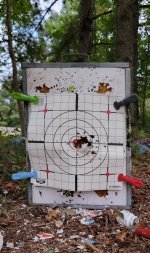SHOTS: ABCDE
PAIRS: AB AC AD AE BC BD BE CD CE DE
It is a statistically significant sample set.
There are 10 data points in the pairs. The average distance between the pairs divided by two represents the average radius of the group.
If you then take the standard deviation of that sample set you can state with a certain confidence the actual deviation of that radius.
The argument the video makes is about the level of accuracy achieved with a five shot group.
He is saying it is very difficult to measure small variations with a small sample set.
Everybody already knows that. It just took him 10 minutes to say it.
i didnt read entire 7 pages, but had to response this
10 data points might be statistically valid for 5 shots, if you think it from maths point of view
but if you try it in real life, you might see that its not
here is follow up video that explains it
this goes to same category as most math that tries to explain real life, while failing miserably
like enthropy on its "gas is even in a box" hypothesis (fyi, its not, ever, it glumps, not even close to even)
i shot 10shots groups, took the results and put lots of pellets in to furthest corner in a closet
few months later i found out that my results were bad, i didnt figure why untill i saw this vid
people who shoot for competition tests hundreds of shots on a batch, as far as i know
Upvote 0

